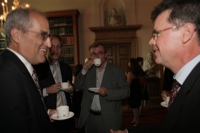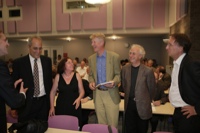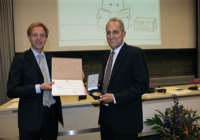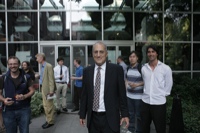Lorentz medal award ceremony, Amsterdam, 28 June 2010
 |
 |
 |
 |
 |
 |
 |
 |
 |
 |
Personal remarks at the award of the 2010 Lorentz Medal to Edward Witten, by Robbert Dijkgraaf (President KNAW), Monday 28 June 2010. With the Lorentz Medal the Royal Netherlands Academy of Arts and Sciences honors the Netherlands' foremost modern theoretical physicist, Hendrik Antoon Lorentz, distinguished professor at Leiden (one of the first chairs in theoretical physics), Nobel laureate in 1902 (the second award in physics), long time chair of this Academy, and scientific diplomat par excellence. The combination of his understanding, wisdom, tact and charm made him famous and admired among his contemporaries. As a chair of the Solvay conferences he was a unifying force of physics in Europe, particularly after the Great War. Albert Einstein said about him "He meant more to me personally than anyone else I have met on my life's journey". In fact, it was Lorentz' telegram that informed Einstein of the experimental tests by Eddington of his General Theory of Relativity. Lorentz was a truly national figure. A hundred thousand people attended his funeral in Haarlem on Friday the 10th of February 1928. At 12 o'clock telegraph and telephone services were stopped for three minutes across the country. Sir Ernest Rutherford words on behalf of the Royal Society summarized his achievements: "Lorentz has made his life into a work of art." The Lorentz medal was established in his honor at Lorentz's golden doctorate on 11th December 1925. The list of awardees is quite impressive. The first Medal was awarded, by Lorentz himself, to his close friend and colleague Max Planck on the 28th of May 1927. Planck accepted this honor, writing to Lorentz on 2nd of Februari 1927 with characteristic modesty: The news has made me happy and glad, even though recently there have been so many wonderful achievements in the area of theoretical physics that I cannot depart from the thought that the first award of the Lorentz medal could easily have found a more worthwhile person. Lorentz died the next year, at the age of 74 after a brief illness. The second medal was awarded in 1931 to Wolfgang Pauli for his exclusion principle. The laudation of Paul Ehrenfest, Lorentz's successor at Leiden, set a high standard of originality, making good use of the fact that Pauli liked a good joke and was not only intellectual, but also physically well-rounded. As Ehrenfest writes in a draft: Why are atoms thick? - because not all electrons fall onto inner rings. - Why don't they do it? - Because of the electrostatic repulsion? -- No, they don't do it for fear of Pauli!!! And so we may say; Pauli himself is so thick, because the Pauli prohibition holds. Ehrenfest had also asked Pauli to wear a formal black suit at the award session. Pauli answered: Just now I ordered a new black suit at my tailor's. But I shall only put it on at Amsterdam, if you promise me to thank me in public, in your official allocution at the Academy [...] Please say in addition that I still got a sense of humor whereas many physicists lose it when they grow old. Indeed Ehrenfest's laudation included the required reference, at least to the first part, as Hendrik Casimir, the first President of this Academy, has recalled in his autobiography. In fact, Ehrenfest spoke the following words in the laudation: You will have to concede, Herr Pauli, by partially waiving your exclusion principle you might free us from many worries of daily life, for instance from the traffic problem in our street and [he added] you might also considerably reduce the expenditure for a beautiful, new, formal black suit. Dear Edward, you are in the comfortable position than many more crazy things are possible than reducing the prize of a new suit without waving any principles of your theories! Now, on behalf of the chair of the Jury, Professor Carlo Beenakker, who unfortunately cannot be present today, I am happy to now read the official laudation, which will be illustrated by a few cartoons to see whether we can still live up to Pauli's principles. Laudation for the 2010 Lorentz Medal to Edward Witten Edward Witten is clearly the most influential theoretical physicist of the past three decades. He has authored more than 300 publications in quantum field theory, string theory, and mathematical physics. His work combines a profound understanding of physics, mathematical elegance, and remarkable clarity of argument. His countless contributions to physics as well as mathematics cover a remarkable broad range of original and pioneering discoveries and theoretical models, many of which bear his name. He has surpassed all other modern scientists in bridging the gap between mathematics and physics, and in doing so has made extremely important contributions to both fields of science. For his contributions to mathematics Witten was awarded the Fields Medal in 1990, being the first and only physicist to win this prize, the highest honour in mathematics. He has received many other prestigious awards, among other the National Medal of Science (2002) and the Crafoord Prize (2008). In his research, Witten focuses on two key themes: supersymmetry, which is clearly a physical concept, and topology, which belongs to the world of mathematics. His brilliant insight is that these two apparently different subjects are closely related to one another at a fundamental level. That insight has enabled him to make many spectacular discoveries of inestimable value for both physics and mathematics. Much of our current knowledge in both these disciplines can be attributed to his work. The Standard Model, developed in the early 1970s to describe all the elementary particles, still has a number of unsolved problems. These include the mass of the Higgs boson, which - according to observations - is much lighter than theory would suggest is natural. This is known as the Hierarchy Problem. Witten was the first physicist to take this problem seriously, and to understand that the answer could lay in broken supersymmetry. The concept of supersymmetry assumes that for every type of boson there is a corresponding type of fermion with the same mass. Since it has not been observed, supersymmetry must be a broken symmetry at low energies. Witten has described the mechanism responsible for this and demonstrated that it offers a natural solution to the hierarchy problem. He has furthermore introduced a criterion, referred to as the Witten Index, that determines whether or not supersymmetry can be broken. His work on the phenomenology of supersymmetry has set the standard in this area of research. Witten has also made many important contributions to supersymmetric gauge theory. In 1994, he and Nathan Seiberg published a precise effective description of supersymmetric gauge theory with enhanced N=2 supersymmetry. Known as Seiberg-Witten Theory, it is an unparalleled theoretical achievement that has given rise to many deep insights into the structure of quantum gauge theory, for example the mechanisms for supersymmetry breaking and the origin of the meson spectrum, again marrying deep physical phenomena to topological structures. Witten has played a leading role in developing string theory, the most comprehensive and, perhaps, the final theoretical description of the fundamental forces and elementary particles. His work on gravitational anomaly in 1984 set the stage for the theoretical breakthrough leading to the first string theory revolution that same year. He subsequently demonstrated how this theory can lead to a realistic description of nature, via compactification on Calabi-Yau manifolds. It was also Witten who, during the second string theory revolution in 1995, recognised the importance of electromagnetic dualities and once again pointed the way towards the most important subsequent theoretical discoveries. He made many of these discoveries himself: the eleven-dimensional supergravity theory that gives rise to string theory, the most promising compactifications of eleven-dimensional supergravity in phenomenological terms, and the relationship between gauge theory and the geometry of space and time, as well as the underlying non-commutative structure. Some years later, in 1997, Witten and Juan Maldacena formulated the holographic relationship between gauge theory and quantum gravity, naming it the anti-de-Sitter/conformal field theory (AdS/CFT) correspondence. This revolutionary discovery has dominated theoretical physics for the past 13 years, with Witten's dictionary playing a key role. Witten's most striking theoretical achievement is his introduction of topological field theory. The most important example in physics is his three-dimensional Chern-Simons-Witten theory. This theory and the closely related Wess-Zumino-Witten model play a role in describing the non-Abelian statistics of quasi-particles in the fractional quantum Hall effect. Topological field theory has many other applications, for example in the quantum mechanical description of black holes. But it is in mathematics in particular that it has led to significant and spectacular breakthroughs, for which reason Edward Witten was awarded the Fields Medal. Witten has produced an astonishingly impressive body of work, and his influence on theoretical physics over the past thirty years is unequalled. He is the most cited living physicist. This association to the legacy of Lorentz is quite appropriate. Hendrik Antoon Lorentz was in many ways the first modern theoretical physicist. At the end of the 19th century, he had a clear vision of how physics would unfold in the next century: Nature should be understood in terms of matter, composed out of elementary particles, interacting through radiation, described by precise mathematical laws. These insights were spectacularly confirmed by the great revolutions of 20th century physics and culminated in the framework of modern quantum field theory. Edward Witten's supreme intellectual leadership, brilliant elegance, intense focus, and singular vision of the course physics could take in the 21st century makes him in all respects a most worthy recipient of the Lorentz Medal.